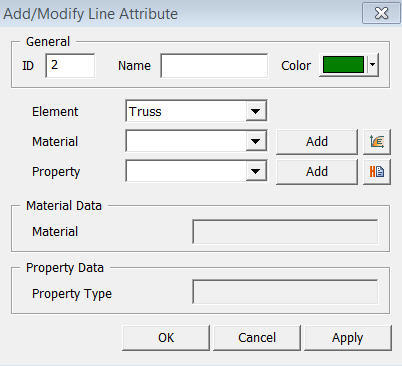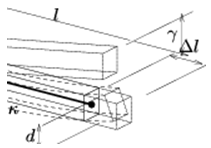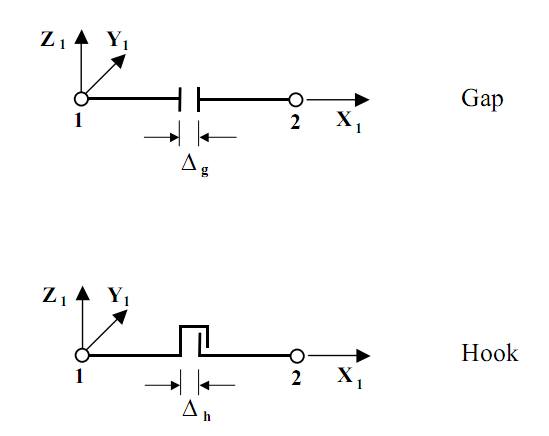Attribute - Line


<Add/Modify Line Attribute>
General
ID: Attribute number
Name: Attribute Name
Color: Select
the color of Attribute
Element Type : Select a line element Attribute type to be created. GTS provides the following element types
Truss
A 2-node truss element. It only transfers force in axial direction. It generally used for Rock-Bolts, Anchor, and Strut.
Truss elements are bars which must fulfill the condition that the dimensions d perpendicular to the bar axis are small in relation to the bar's length l [Fig.1.0].

<Figure 1.0>
The deformation
of truss elements can only be the axial elongation  , there is neither bending nor shear deformation. Truss elements may be
used to analyze bar structures with hinged connections like space decks,
stiffeners in walls or structural parts connected by hinges. Also in modeling
of discrete reinforcement bars, truss elements may be used.
, there is neither bending nor shear deformation. Truss elements may be
used to analyze bar structures with hinged connections like space decks,
stiffeners in walls or structural parts connected by hinges. Also in modeling
of discrete reinforcement bars, truss elements may be used.
Beam
A 2-node beam element. It has stiffness about tension, compression, shear. bending, and torsion.
Beam elements are bars which must fulfill the condition that the dimensions d perpendicular to the bar axis are small in relation to the bar's length l [Fig.2.0].

<Figure 2.0>
Beam elements may have axial deformation
 ,
shear deformation
,
shear deformation  , curvature k and torsion,
therefore they can describe axial force, shear force and moment. Beam
elements are typically used to analyze two- and three-dimensional frames.
In combination with continuum elements they can also be used to model
stiffeners in plates or shells.
, curvature k and torsion,
therefore they can describe axial force, shear force and moment. Beam
elements are typically used to analyze two- and three-dimensional frames.
In combination with continuum elements they can also be used to model
stiffeners in plates or shells.
Note:
1) Beam elements can be used in 2D slope stability analysis.
2) High-order beam elements are only available when the DIANA solver is being called. Not available when the FES solver is called.
3) Beam elements can be used in 2D dynamic analysis.
4) Low order beam elements can be used in 3D dynamic analysis.
Pile
A special embedded type beam element. It can be used without any nodal connectivity., and it considers the interface effects during the analysis.
Note:
1) Pile elements cannot be used in 2D analysis.
2) Pile elements can only be used in 3D analysis.
Embedded Truss
A truss element which can be used without any nodal connectivity.
Tension Only/Hook
Tension-only truss element is capable of resisting only an axial tension force. Tension-only elements can exhibit stiffness depending on the condition defined by the sign of the member forces or relative displacements. If a member force is negative (compression), its stiffness becomes zero. "Hook" refers to the element having a constant initial distance. The initial distance is referred to as hook distance "delta h."

where delta h,

Compression Only/Gap
Compression Only truss elements transfers only an axial compression force. Only when a member force is negative, it exhibits the same stiffness similar to the Tension only element. Similarly, it has a "Gap Abiilty", so only when the relative displacement is smaller than or equal to a constant initial distance "delta g" , termed as gap distance, it exhibits its stiffness as the following form:

Plot Only(1D)
Geogrid(1D)
It is a 1D element which only has axial tensile strength. It doesn't have any bending stiffness. Generally, it is used for ground reinforcement.
Material
Select
Material data that will be included in the Attribute. To add new Material
data, click  or
or  button.
button.
Property
Select
Property data that will be included in the Attribute. To add new Property
data, click  or
or  button.
button.